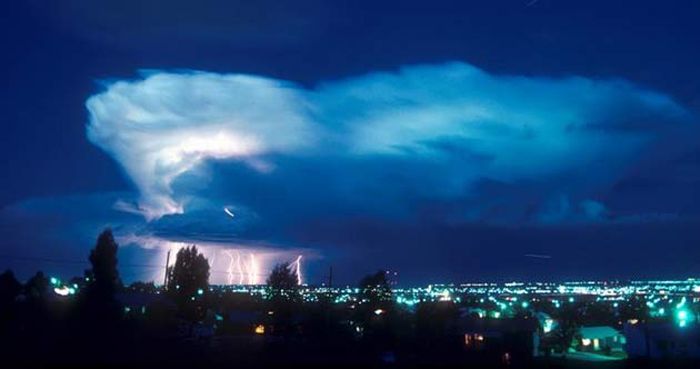
For Severe Weather, 'Is This Climate Change?' Is the Wrong Question (Op-Ed)

Jeremy Deaton writes about the science, policy and politics of climate and energy for Nexus Media. You can follow him at @deaton_jeremy. He contributed this article to Live Science's Expert Voices: Op-Ed & Insights.
For the first five years of his career, Alex Rodriguez averaged 37 home runs a season. Then, he moved to the Texas Rangers, where his average swelled to 52 home runs a season. A-Rod's other statistics — runs batted in, slugging average — rose as well. It is difficult to account for the sudden surge in his output without the influence of performance-enhancing drugs, which is why few people batted an eye when Rodriguez admitted to using steroids during his time with the Rangers.
Scientists like to point to the use of steroids in baseball as a way to explain climate change. Each baseball A-Rod sent soaring over the back wall could be attributed to steroids, but many would have been home runs anyway. So it is with global warming. Weather happens, with or without human influence, but rising temperatures, record storms and historic flooding are difficult to explain without heat-trapping greenhouse gases — the steroids of the global climate system.
Still, elegant analogies haven't stopped journalists from asking, "Is this climate change?" any time a hurricane makes landfall, much to the frustration of scientists.
Jason Smerdon, a climate scientist at the Lamont-Doherty Earth Observatory at Columbia University, says the question is "a straw man." "In any individual event, it's likely that climate change is acting in the background in one manner or another," he said. "I think the most egregious thing that the scientific community tends to push back on is the idea of whether or not this event wouldn't have happened at all without climate change."
Asking the right questions
Instead of asking, "Is this storm due to climate change?" reporters should ask, "How much more likely has climate change made this storm?" or "How much of this storm is climate change?"
Sign up for the Live Science daily newsletter now
Get the world’s most fascinating discoveries delivered straight to your inbox.
The A-Rod analogy isn't the best tool for grappling with these questions. Instead, it's designed to explain trends, not to demonstrate whether and to what extent climate change affects specific extreme events.
So, here is a better analogy for understanding abnormal weather, courtesy of the National Center for Atmospheric Research. Imagine yourself cruising down the highway. If you accelerate by 10 or 15 mph (16 to 24 km/h), you are more likely to crash — and if you do get in an accident, you are more likely to sustain injuries, according to the World Health Organization.
This is how climate change works. Global warming loads the dice for floods, droughts and heat waves, and it makes the resulting catastrophes more severe.
Smerdon recently co-authored a paper that looked at the influence of climate change on the recent California drought. Atmospheric warming is stealing more and more moisture from the soil in California, even as rainfall continues to vary, he said.
"It's kind of like your salary going up and down from year to year and a debt collector coming back each year and taking more and more of the money that you're making," Smerdon said.
Smerdon and his colleagues teased out the effect of the debt collector. "Because that temperature signal, a portion of it, can be attributed to climate change," he said, "we were able to say… that 15 to 25 percent of the severity of that drought was a consequence of climate change."
Similarly, scientists can discern, to some extent, the influence of climate change on heat waves, floods and storms. "Think of the devastating storm surge associated with Sandy that was on the order of feet, and that was acting already on top of sea-level rise on the East Coast on the order of a foot," Smerdon said. Rising oceans made Sandy even more destructive, extending the reach of coastal flooding to neighborhoods that would have otherwise been spared, he noted.

As the field of climate attribution develops, scientists are increasingly able to pinpoint the influence of climate change on specific events. A recent report from the American Meteorological Society evaluated the role of climate change in 28 extreme weather events from 2014, including heat waves in Argentina, drought in East Africa and cyclones in Hawaii.
"As the science of event attribution continues to advance, so too will our ability to detect and distinguish the effects of long-term climate change and natural variability on individual extreme events," Thomas Karl, director of the National Oceanic and Atmospheric Administration's National Centers for Environmental Information, said in a statement. "Until this is fully realized, communities would be well served to look beyond the range of past extreme events to guide future resiliency efforts."
The bottom line is that climate change is rewriting the rules of the game. It's not as though planetary warming is responsible for some storms and not others. Climate change is pervasive, and its effects are varied. But even in the absence of climate attribution studies, it's clear that if the weather looks different, people shouldn't be surprised.
Follow all of the Expert Voices issues and debates — and become part of the discussion — on Facebook, Twitter and Google+. The views expressed are those of the author and do not necessarily reflect the views of the publisher. This version of the article was originally published on Live Science.












